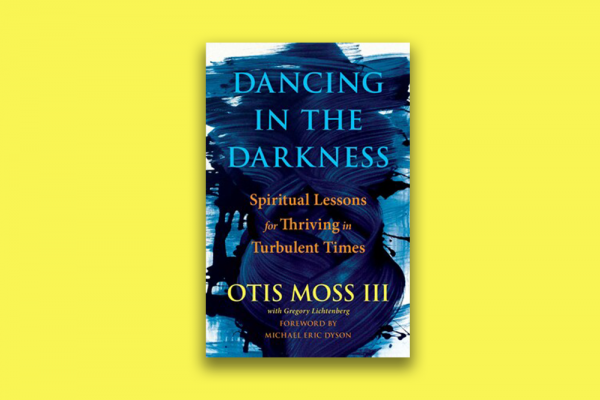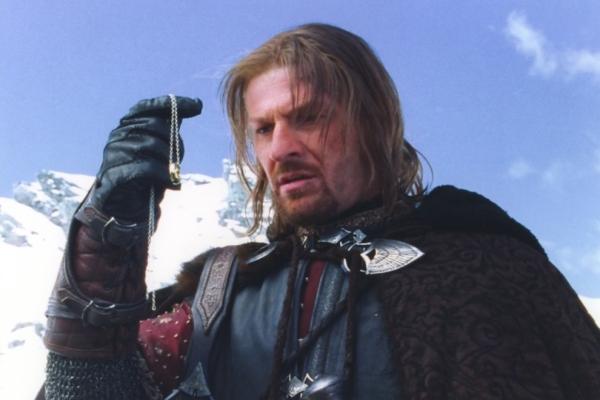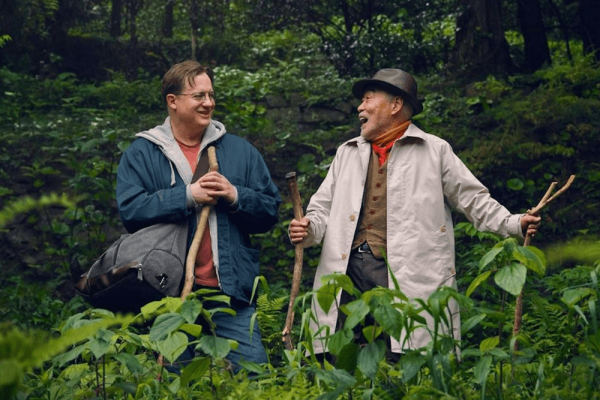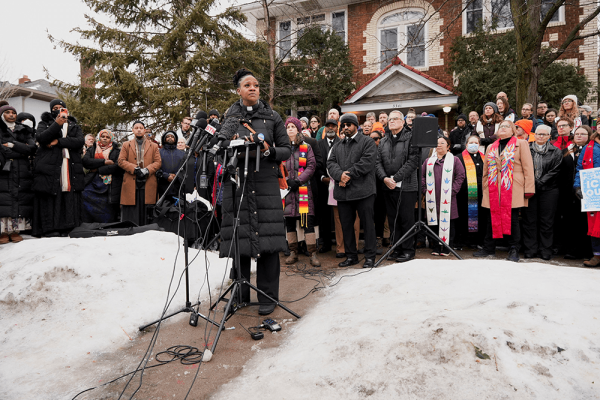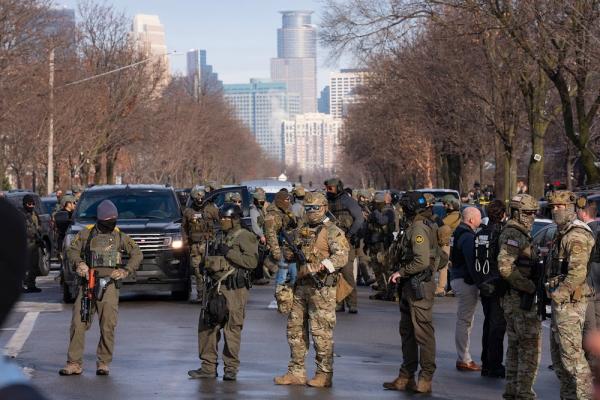When I first picked up Rev. Otis Moss III’s latest book, Dancing in the Darkness: Spiritual Lessons for Thriving in Turbulent Times, I was reminded of the title of a poem by Hanif Abdurraqib, “How Can Black People Write About Flowers At a Time Like This?” My initial impulse was to ask Moss a similar question: How can Black preachers write about dancing at a time like this?
Dancing in the Darkness is best understood as an addendum to Moss’ seminal work Blue Note Preaching In a Post-Soul World: Finding Hope In an Age of Despair. If you have not read or listened to his 2014 Lyman Beecher Lectures at Yale Divinity School, off of which Blue Note Preaching is based, they are worth your time.
Performing or preaching the blues, as Moss describes them, requires us to face pain and sorrow. “Preachers of African descent were born outside of the American project, forced to gaze through the window of democracy,” Moss writes in Blue Note Preaching. Moss notes that this “distance and yearning” gives preachers of African descent a “second sight.” It is the constructive and creative imagination of preachers, poets, artists, and freedom fighters who must confront the suffering and hatred of the past in order to envision a new future.
In Dancing in the Darkness, Moss urges readers to move through the sorrow of the blues to what he calls “jazz politics” — one of collaboration, community participation, and dialogue: “If we had a jazz version of democracy in our politics, where each of us could play all our notes, even the blue notes, and contribute them to the music of the whole, then dialogue and honest debate would be the norm rather than demonization and incivility.”
With this attention to “second sight,” Moss is responding to the sound of fear. The book’s title refers to an anecdote that Moss tells in the book: Plagued by threats of white supremacist violence against his family and his congregation of Trinity United Church of Christ in Chicago, he hears an unfamiliar noise in his family’s home late at night. When he comes downstairs, armed with a baseball bat, he traces the sound to his daughter’s room only to find his daughter practicing a ballet routine in the darkness. “Unless we have better guidance,” writes Moss, “our eyes go to the shadows, and as we peer into darkness and worry what may jump out, the shadows become all we see.”
How can one practice joy in the midst of despair and danger? Drawing heavily on Martin Luther King Jr.’s tradition of nonviolence, Moss directs his blues sensibility to a United States that is far more polarized than it was when he stood at the Yale lectern in 2014. When Moss first invoked the blues, the country had yet to experience the darkness of the Trump administration, the shootings of George Floyd, Breonna Taylor, and Ahmuad Arbery, and the continued shadow of COVID-19.
In the midst of such darkness, Moss draws from his experience as a pastor as well as the experiences of Black freedom fighters like King and Howard Thurman to bear witness to how one can not only survive darkness, but thrive in it. “It was the combination of love and justice that set young Howard Thurman, his future student Martin Luther King Jr., and the American civil rights movement on a path toward the light.”
Moss recognizes that what the country faces in this “midnight hour” is not only a political crisis, but a spiritual one. “What we yearn for will never be found by rearranging politicians and policies. That, I believe, is why our feeling of unease cuts deep.”
Yet, where does the work of love and justice take root if not in the blood-soaked soil of current events and turbulence? Moss generally doesn’t dwell on the specificity these “darknesses” in the book, though he does briefly mention societal problems such as the prison industrial complex, police brutality, and mass shootings, namely the Charleston shooting at Mother Emanuel.
While specific injustices are mentioned, there is no in-depth critique of the divisiveness and misinformation of the Trump era as such, nor the callous government responses to the immigration crisis at the border, or the apocalyptic climate catastrophe. Ultimately, Moss looks beyond the nation’s headlines and instead turns to the Negro spirituals as a source for hope in the face of the compounding darkness.
By making the timeless plea to embrace joy in the face of danger, Moss situates Dancing in the Darkness in the enduring legacy of blue note sermons, Negro spirituals, and religious hymns that subvert oppression and transform struggle into spiritual resistance. One such example is his treatment of the hymn, “Amazing Grace,” which was composed by the former slaver, John Newton, and was alchemized by the musical tradition of the enslaved Africans Newton transported. “That poem by the formerly anti-religious slaver became one of the most important hymns in the world, a global anthem of love and justice,” writes Moss. “It was a global, interracial collaboration unplanned by human composers. Like a great jazz improvisation, it took its contradictory parts and made something miraculous.”
The lessons that Moss surfaces in Dancing in the Darkness are not taken from a progressive playbook nor are they steeped in political theory. These lessons were learned in the tobacco fields of Maryland, the farmlands of Georgia, and from Native American and West African peoples — a throughline of historical wisdom that Moss draws on instead of hyper-focusing on the glaring problems of the day.
Echoing the sentiments of a public-facing letter he addressed to his son in 2016, Moss speaks about his role as a parent and why it is so crucial to reclaim and learn from the past. “History for a parent of African American descent is both elusive and sacred,” he writes in the book. “ Elusive because of the hindrances, intentional and unintentional, that keep my family from a basic natural right: the ability to explore and to know our past.”
By looking to his past, Moss avoids the kind of spiritually-numbing reporting and voyeurism that he criticizes in Blue Note Preaching. He is calling upon all of us to look at the world through a prophetic lens in which news headlines are not cultural thermostats that set the temperature of social progress, but cultural thermometers that tell us what the temperature is, reminding us how far we’ve come and how far we have yet to go.
“I have written this book to bring news that will affect all who are comfortable,” Moss writes. “The bad news: It is midnight. But I have also written this book to bring news that will comfort the afflicted. The good news: It is midnight.”
A year before his death, King delivered his speech “Beyond Vietnam: A Time to Break Silence,” in which he spelled out plainly the urgent need to address the darkness of the war in Vietnam: “We are now faced with the fact that tomorrow is today. We are confronted with the fierce urgency of now,” said King. “In this unfolding conundrum of life and history, there is such a thing as being too late.”
While King’s charge of urgency pulsates throughout Dancing In the Darkness, there were moments when I wondered if Moss holds back when describing the dark moment that we are in. The fear that gripped him in his home was real as were the threats lobbied against it. After all, he walked downstairs with a baseball bat prepared to do what was necessary to defend his family.
But here the power of this little book surfaces. Dancing at the midnight hour will not make the morning come faster, but will make the night bearable.
Got something to say about what you're reading? We value your feedback!
